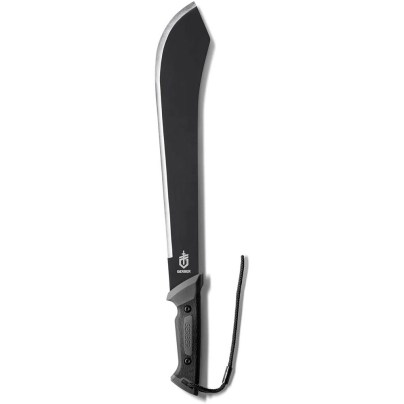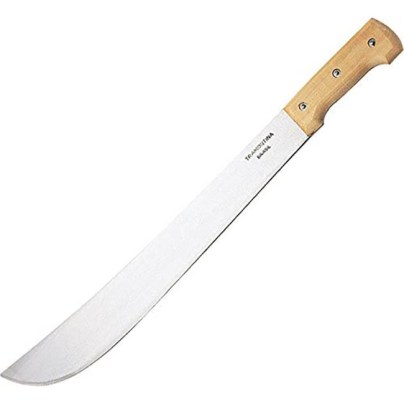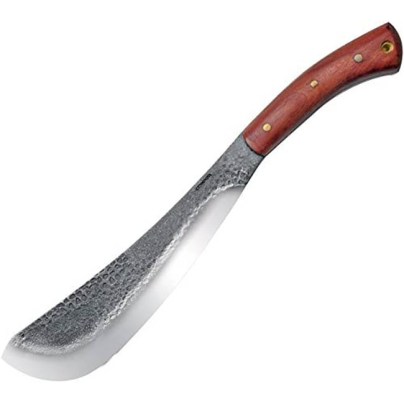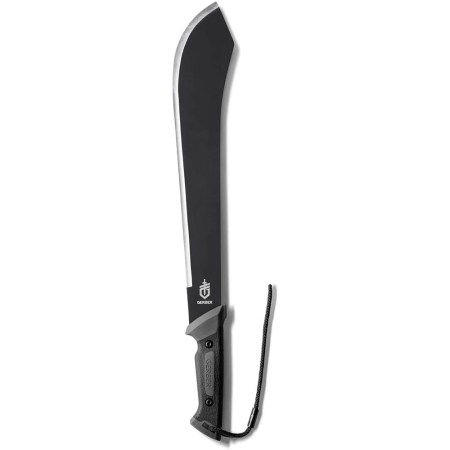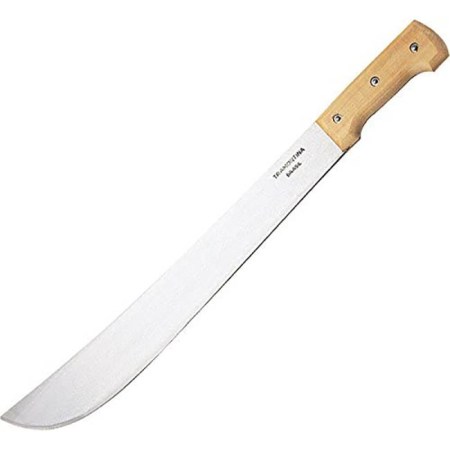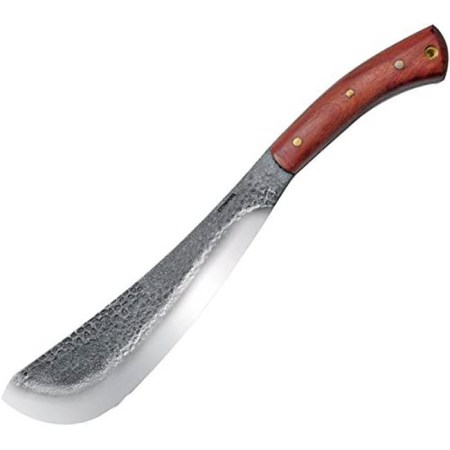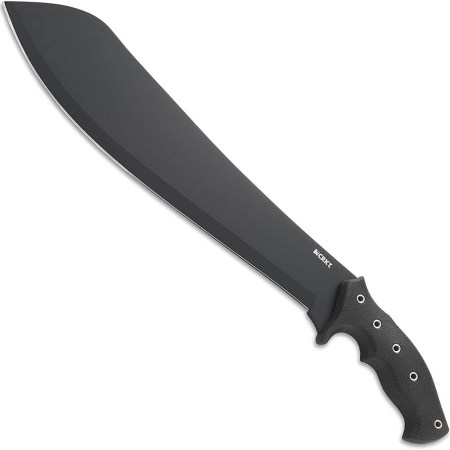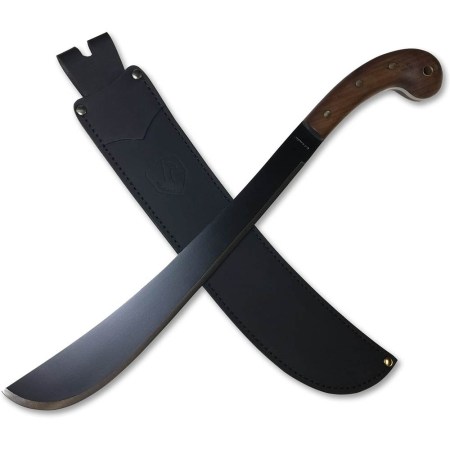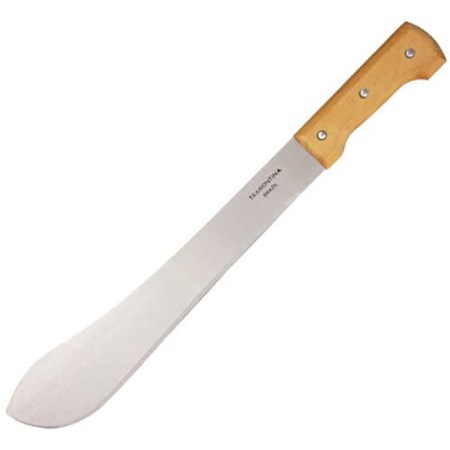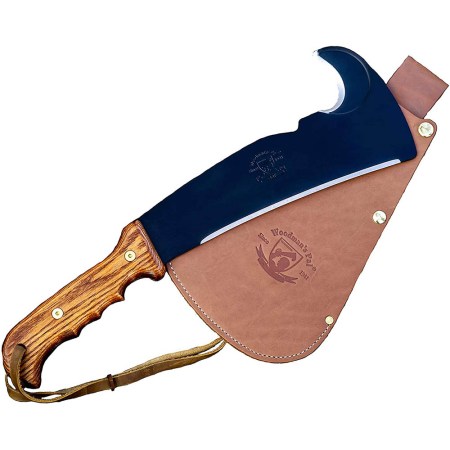We may earn revenue from the products available on this page and participate in affiliate programs. Learn More ›
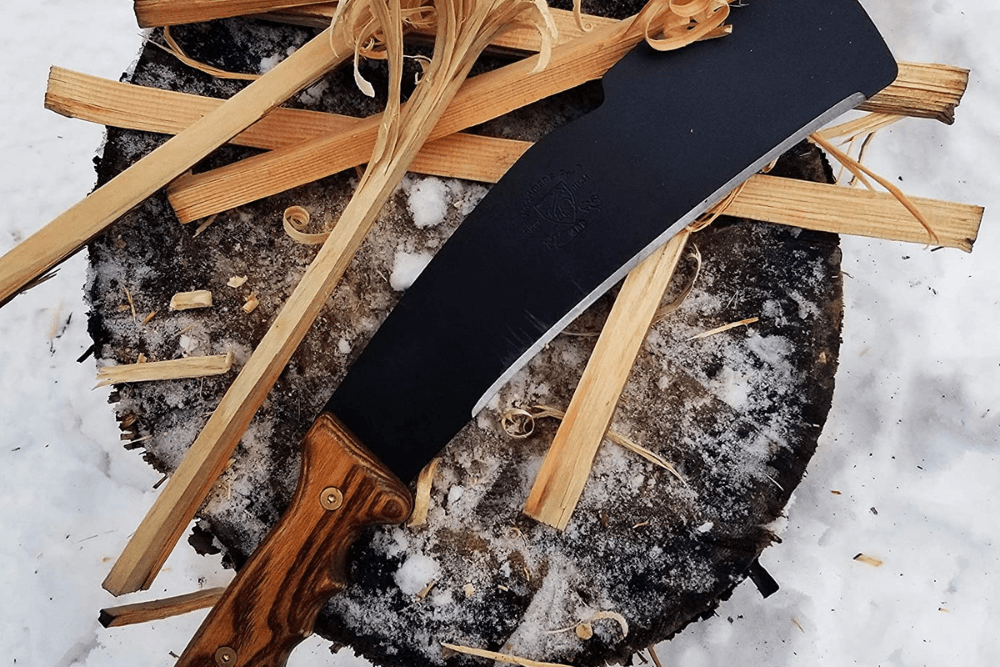
If you think machetes are only for explorers hacking their way through the jungle, you may want to take a closer look. These handy tools have plenty of uses around the yard and garden, as well as at a campsite and in the bush. When you have lots of cutting to do and only want to carry a single tool, a machete can take the place of an axe, saw, scythe, sickle, garden knife, loppers, or pruners.
Machetes come in various shapes and sizes, offering numerous alternatives for cutting capabilities and user comfort. The general design features a long, tapered blade between 10 and 28 inches that is broader in the front end than it is near the handle for increased leverage while chopping. One edge is sharp from just above the handle to the blade tip. Machetes may have curved or nearly straight blades. If you’re looking for a dependable cutting implement, read on to find the best machetes for garden, landscape, and outdoor activities.
- BEST OVERALL: Gerber Gator Bolo Machete
- BEST BANG FOR THE BUCK: Tramontina Machete
- BEST SHORT: Condor Tool & Knife, Pack Golok
- BEST HEAVY DUTY: CRKT Halfachance Fixed Blade Parang Machete
- BEST FOR CLEARING BRUSH: Condor Tool & Knife, Golok
- BEST FOR CHOPPING WOOD: Tramontina Bolo
- BEST FOR CAMPING: Woodman’s Pal 2.0
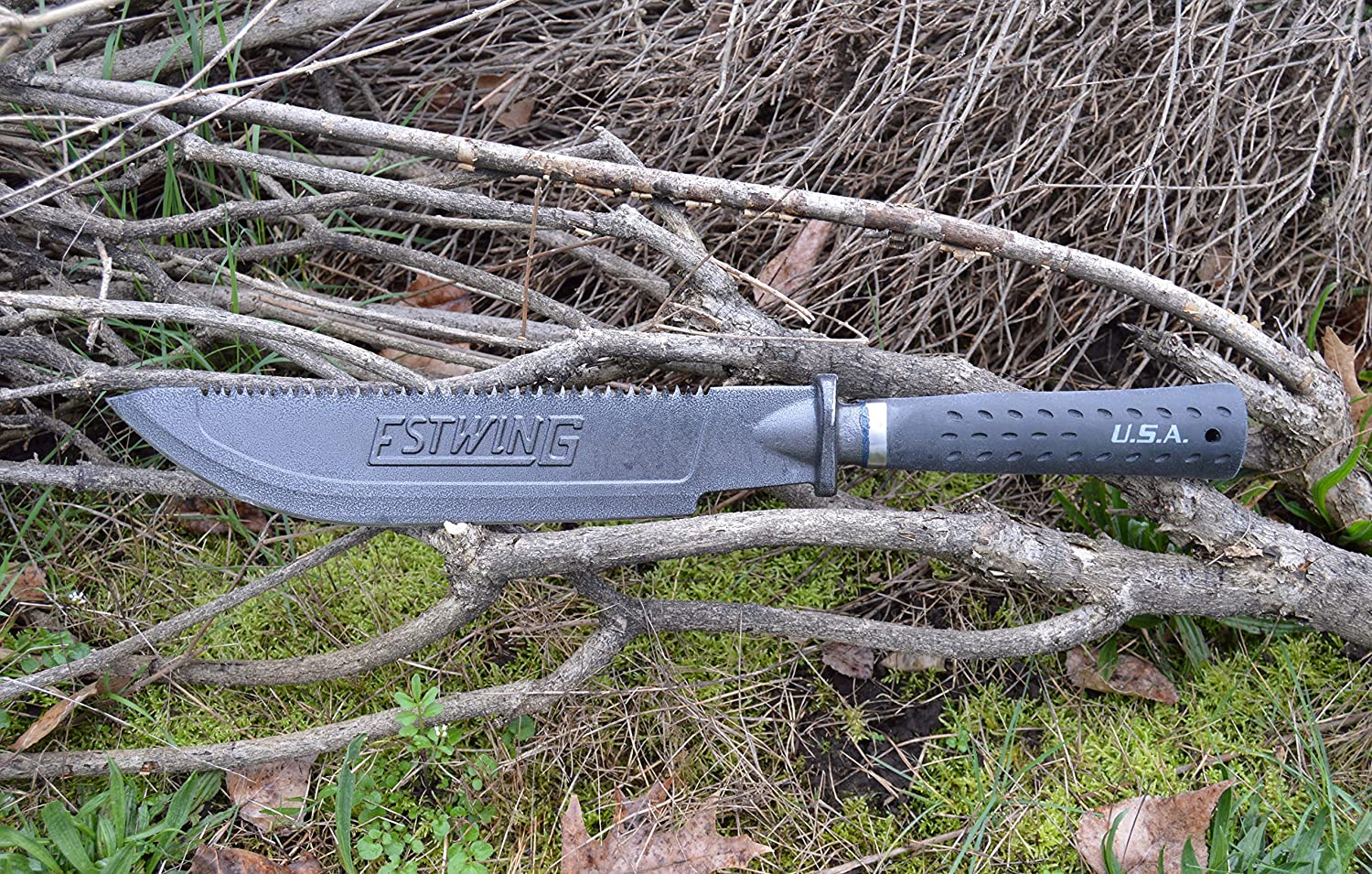
Types of Machetes
Machete-type tools arose all around the world. They are truly local tools, with each maker adapting their design to the local conditions. As cultures move and merge, designs change as well. Ahead are seven of the most familiar machete types. The descriptions are very generalized, as there is a significant overlap in design and styling, so one manufacturer’s Golok may look nearly identical to another’s Parang, and so on.
Latin
Latin-style machetes, popular in Latin America, are what most Americans envision when we think of machetes. These are general-purpose machetes with straight-backed, evenly-weighted blades. They are most effective at clearing green vegetation but are also capable of limited chopping and splitting.
Kukri
Kukris, sometimes called Gurkha blades, are large, all-purpose cutting tools from Nepal. They traditionally feature a pointed tip for piercing, a wide midsection for chopping, and a narrow section nearest the handle for more controlled cutting. They are traditionally used for chopping firewood, butchering meat, cutting vegetables, opening cans, and more.
Bowie
The Bowie knife was named for the 19th-century, American frontiersman Jim Bowie. It is popular with survivalists and outdoorsmen for its signature, clip-point design, which makes it ideal for skinning wild game. It is less weight-forward than other machetes, making it more agile in-hand for slicing and chopping.
Panga
The Panga machete design is popular in Africa and the Caribbean. It features a straight cutting edge that curves upward to form a deep “belly” near the upturned tip. The resulting front-loaded weight provides extra leverage for chopping, and the extra width provides curvature for slicing. Pangas excel at chopping and slicing through moderately-thick, woody vegetation.
Bolo
Bolo machetes come from Southeast Asia, where they are commonly used as agricultural tools. Due to the bulge at the tip that adds weight to the front of the blade, they work well for harvesting narrow row crops like rice, peanuts, and soybeans. Some bolo machetes are partially sharpened for a short distance on the backside of the blade tip for additional cutting ability.
Parang
Parang machetes feature a distinctive curved shape in which both the edge and spine of the blade are curved, like a scimitar. They are generally long, some up to 36 inches in length, and are weighted either evenly or slightly forward. The shape lends itself to slicing or chopping woody material without lodging in the wood.
Golok
The word “golok” is often used interchangeably with “parang.” Though traditionally the golok is heavier and shorter, between 10 and 18 inches, it includes a similarly curved and heavy blade. The blade is heaviest in the center and flows away in an upturned tip. The shorter blade is useful for working in thick brush and is convenient for packing.
What to Consider When Choosing the Best Machete
With numerous differences in weight, size, materials, and overall machete design, it’s important to weigh the options carefully before purchasing. Read on to learn about the criteria used to choose our list of top picks.
Intended Use
As seen in the earlier descriptions, different types of machetes are suited to different tasks. Long, thin, straight blades excel at clearing tall, weedy grass and thin, green brush. Thick, curved, weighted blades are excellent choppers for woody material. A shorter blade is easier to pack along on a camping trip than a longer one, but longer blades provide more cutting power and longer reach. The right machete will be the one that accomplishes the most of your intended tasks the most of the time.
Blade Material
Machete blades are made from one of three materials: carbon steel, stainless steel, or high carbon stainless steel.
- Carbon steel is the traditional, functional material for machete blades. It is harder and less expensive than stainless and retains its edge longer, but it is vulnerable to rust and difficult to resharpen.
- Stainless steel is most used for decorative and ceremonial blades. It is rust-resistant and requires less maintenance than carbon steel, but it is softer, more expensive, and dulls more easily.
- High carbon stainless steel offers the benefits of both carbon steel and stainless. It is rust-resistant and durable, but it is expensive and has a low heat tolerance before becoming brittle.
Most machete blades are simply polished and oiled, and need regular clean up and oiling to stay rust-free. Some manufacturers use a coating to protect machete blades from rust. Powder coating is a dry material that is electromagnetically bonded and heat cured to the metal for a durable rust- and scratch-resistant finish. Diamond-like carbon (DLC) finish is one of the strongest black finishes, holding up much longer than powder coat. Finishes eventually scratch and wear off to reveal the metal beneath, which then needs to be maintained like a polished blade.
Blade Design
A quality blade begins at the tang, or the back end of the blade that connects to the handle. For strength and safety, machetes should feature a full tang, meaning that the tang extends through the full length and width of the handle, forming its core.
Machete blades range from about 10 inches to 28 inches long. Shorter blades allow greater agility and are more convenient to pack. Longer blades offer a longer swing arc to clear large areas quickly.
The shape of the blade edge makes it more suitable for specific tasks. Straight, balanced blades are best for clearing tender vegetation like coarse grass and herbaceous vegetation. Thick, woody vegetation requires a blade that is full near the middle and tip and narrow toward the handle. This forward-weight configuration concentrates more cutting energy at the point of impact. Blades with an upward curve slice and chop efficiently without getting lodged in woody material. A downward curve provides more chopping power for an axe-like performance.
The edge may be sharpened in different ways for different cutting purposes. A fine or narrow edge (think “razor-sharp”) is useful for game cleaning. A broad edge (like an axe bit) is more suitable for chopping. A medium edge is best for across-the-board utility.
Blade Features
One traditional feature that is incorporated into some machete blades is the fuller, or groove, down the length of the blade. While it adds a decorative element, it also serves to lighten and strengthen the blade. The effect is most beneficial on longer, thicker blades.
Contemporary machete designs sometimes include other feature upgrades that let you multitask even more. A bill hook, or reverse hook, is useful for precision branch pruning and allows the user to reach and grab thorny material without injury. A sawback can quickly cut through thicker saplings and branches with a cleaner cut than a chopping blade.
Handle Material
With a full tang, the handle’s job is to provide grip and cushion the hand. Wooden handles provide a good grip and are warm and lightweight, but they require cleaning and maintenance to prevent damage. Molded plastic is inexpensive and low maintenance but can become brittle over time. Leather and rubber are comfortable and provide good grip, but leather can become slippery or wear out, and rubber can tear.
The top-of-the-line material for a machete handle is Micarta. It is made from heat-treated layers of linen, canvas, fiberglass, paper, or plastic. It is very strong, durable, comfortable, and also expensive.
Handle Design and Features
The handle should feel comfortable while working with the machete. It needs to be large enough, in terms of length and girth, to grip comfortably for an extended period without causing hand fatigue. Two-handed machetes are available with longer handles for added strength while cutting through tough vegetation. Many machetes include a wrist lanyard to prevent the tool from slipping out of your hand.
A quillon handle is a straight handle that simply envelops the tang. Most machetes have quillon handles. This kind of handle often includes raised areas at the ends for a more secure grip but does not provide knuckle or hand protection.
A D-ring handle features a protective cover over the knuckles that also reduces slipping. These handles do not fit everyone, and the added material makes them heavier to carry.
Crossguard handles offer protection by reducing the risk of the hand slipping off the handle onto the blade as well as providing protection against knuckle injuries. This feature is also a bit larger and heavier, and it does not fit all hands.
Weight
While machetes are considered lightweight clearing and cutting tools, weights vary significantly among the different sizes and types. Machetes with broader, heavier blades move more slowly and provide more force. They excel at chopping thick, woody material. Lightweight blades move more quickly and are best for clearing succulent vegetation and light brush.
With so many available configurations, it’s important to recognize what features and designs add to the overall weight of the blade. More metal means more weight. Blade length, breadth, and thickness are all contributors to weight. To reduce total weight, look for blades that are either shorter, narrower, or thinner, but keep in mind that each dimension plays into performance. Balance is important as well, with chopping blades benefitting from weight-forward designs and clearing blades employing a more balanced design.
Sheath
The sheath protects the blade and the user when the machete is not in use. It’s also a good way to attach the tool to your belt or protect adjacent items inside a pack or tool bag. Machete sheaths are made of sturdy materials such as leather, molded plastic, and heavyweight fabrics like nylon. Leather is tough, but sensitive to moisture, and requires more maintenance in terms of cleaning and conditioning. Molded plastic is durable but bulky. Heavy-duty fabrics are weather-resistant but more susceptible to damage from sharp blades.
Our Top Picks
These best-in-show products are known for their quality and functionality. Each machete is the top pick in its category.
Best Overall
Gerber Gator Bolo Machete
See ItThe Gerber Gator Bolo Machete is a general-purpose, carbon steel machete with added weight at the tip for increased chopping ability. The overall 22.5-inch length includes a 15.5-inch straight-edge blade with a slight rise at the tip for efficiently clearing large areas. Full-tang construction, an overall weight of 20.8 ounces (without the sheath), and a bulging blade tip provide excellent power transfer that makes chopping saplings and tough, woody vines easy. The Gator Grip handle provides excellent grip, even in wet conditions, and is equipped with a lanyard for added safety and secure retention. This machete comes with a nylon sheath with a belt loop and D-ring for multiple carrying options.
Best Bang For The Buck
Tramontina Machete
See ItThe Tramontina Machete features a weight-balanced Latin design for general purpose cutting, plus high carbon steel and a full tang for excellent durability. The riveted wooden handle is comfortable in hand and impact resistant. The overall 24-inch length includes an 18-inch straight-edge blade that rises slightly at the tip for excellent reach and fast work in coarse vegetation. This machete is suitable for chopping woody vines and saplings as well. This is a high-quality tool for half the price of many comparable blades. The sheath is sold separately.
Best Short
Condor Tool u0026 Knife Pack Golok
See ItThe Condor Tool & Knife Pack Golok is a small 17-inch machete with an 11-inch blade, making it a comfortable size to carry on the belt and convenient to pack for trips to the woods. The weight-forward design is useful for chopping wood or preparing food. Its total weight is 28 ounces (without the sheath). High-quality construction and materials throughout include a 5-millimeter thick, high carbon steel blade; triple-riveted hardwood handle with lanyard hole; brown leather belt sheath; and the Condor classic blade finish.
Best Heavy-Duty
CRKT Halfachance Fixed Blade Parang Machete
See ItThe CRKT Halfachance Fixed Blade Parang Machete is made of 65Mn steel for a combination of hardness, edge-holding ability, and durability. The 14-inch blade features a long arc edge, meaning the fullness of the blade is carried evenly through the tip for a good combination of balance and power. It is powder-coated for protection against rust and corrosion. This machete is designed to slice and chop equally well. The ergonomic, double injection molded handle reduces user fatigue and includes multiple lanyard holes for different grip options. It includes a reinforced nylon sheath with an adjustable belt loop system and paracord fob. The overall length is 19.5 inches, and it weighs 6.1 ounces.
Best For Clearing Brush
Condor Tool u0026 Knife Golok
See ItThe Condor Tool & Knife Golok features a 14.25-inch straight-edge, high carbon steel blade that rises up near the tip as well as a slightly curved spin that adds weight to the front end. In addition, the blade is finished with epoxy black powder coating for outstanding rust and corrosion resistance. The full-tang, walnut handle curves slightly downward to add leverage for slicing through dense brush or chopping wood. The overall 19-inch machete provides good reach for fast, efficient work and includes a black leather belt sheath.
Best For Chopping Wood
Tramontina Bolo
See ItThe Tramontina Bolo is a no-frills machete that simply works. It is made of 2.25-millimeter high carbon steel with full-tang construction for excellent durability and control. The triple-riveted hardwood handle is comfortable in-hand and provides a good grip. The overall 19-inch machete features a 14-inch blade for good reach while clearing large areas. The blade edge is straight through the midsection and then rises in a round curve to the tip. The bulge at the blade tip adds weight to increase its chopping force. The sheath is sold separately.
Best For Camping
Woodman's Pal 2.0
See ItThe Woodman’s Pal 2.0 features a unique design for use as a machete, shovel, brush axe, and knife. The blade is laser cut from .110-inch thick, high carbon spring steel; hand sharpened; and finished with solar matte powder coat for excellent rust and corrosion resistance. The double-riveted, ash wood handle is urethane coated and hand-rubbed with beeswax for added grip and protection. The handle is extra long to allow for a variety of grips and includes an adjustable lanyard. The premium leather sheath is made with brass snaps, pre-treated with Neatsfoot Oil, and includes an easy-carry belt loop. It ships in a gift box with four reprints of vintage owner manuals, including a use-and-care guide, as well as a Lansky 280-grit sharpening stone. The overall length is 17 inches, the cutting area is 10.5 inches, and the sickle hook is 2.5 inches. It weighs 21 ounces (without the sheath).
Tips for Using a Machete Safely
Swinging a sharp blade in dense foliage comes with inherent dangers, so it is important to use the machete as safely as possible. Start by observing the surroundings. Be aware of dangers to yourself and others, including springy branches, overhanging obstacles, and people in the area who could be struck by the blade or falling vegetation.
Wear safety gear such as gloves, boots, and eye protection to avoid injury in case of accidental contact with the sharp blade or flying debris. Prolong the sharpness of the blade by using proper cutting techniques and avoiding impact with surfaces like rock and metal.
- Be sure that bystanders are well outside the cutting area.
- Maintain a sharp blade to maximize cutting efficiency and reduce user fatigue.
- Keep the work in front of you. Do not swing across your body or out to the side.
FAQs About Your New Machete
If you still have questions about using a machete, read on for several pointers on using and caring for your new tool.
Q. Are machetes legal to own and use?
Machetes are classified as agricultural tools and are allowed for use as such.
Q. What should I look for in a machete?
Start by choosing a machete type that is designed to do the work you need to get done. It should be comfortable to use and made of high-quality materials.
Q. How do you properly swing a machete?
First, pinch-grip the handle securely with the thumb and forefinger to form a fulcrum. Allow the other three fingers to hold the base of the handle loosely as shock absorbers. There should be some wiggle room. Never squeeze the handle so tightly as to leave a print on the palm.
With the vegetation directly in front of you, raise the blade and direct your full arm to strike at a downward angle. Lead the downswing with the elbow and follow through with the shoulder. Use the loose fingers and wrist to flick downward on impact with woody material or slightly upward when clearing grassy vegetation.
Q. How do you sharpen a machete?
For general utility, sharpen the blade to a 25-degree angle. For finer work, it can be as narrow as 20 degrees. For coarse chopping, it could be as broad as 35 degrees. The angle is created by making two equal bevels on opposite sides of the blade. For instance, a 25-degree angle is formed by sharpening to a 12.5-degree bevel on either side of the blade edge. This can be done with a belt sander, grinding wheel, or mill file.
To sharpen with a file, clamp the blade into a vice at the desired angle and push the file across the blade, and then turn the blade over and repeat on the opposite side. The process for sharpening with a belt sander or grinding wheel is similar, but the machete is held to the belt or wheel instead of being clamped in a vice.
